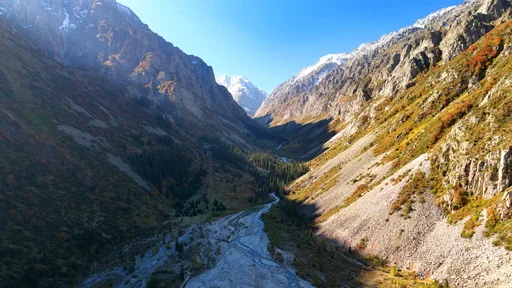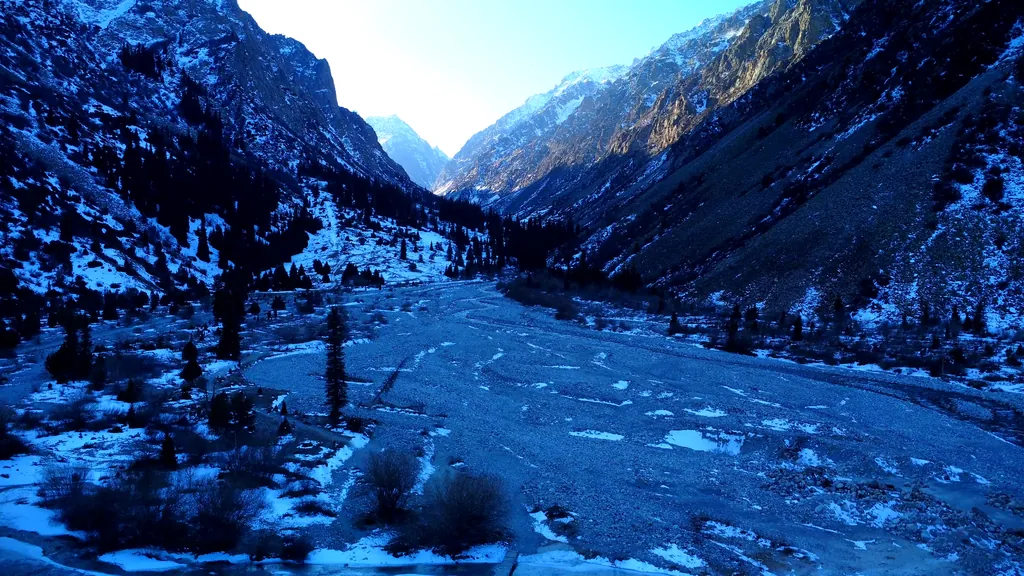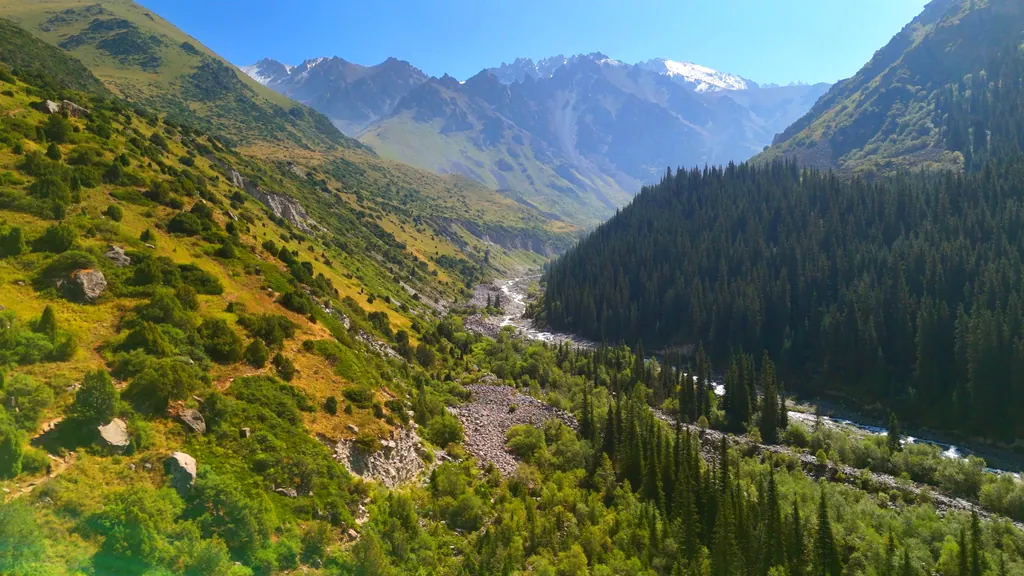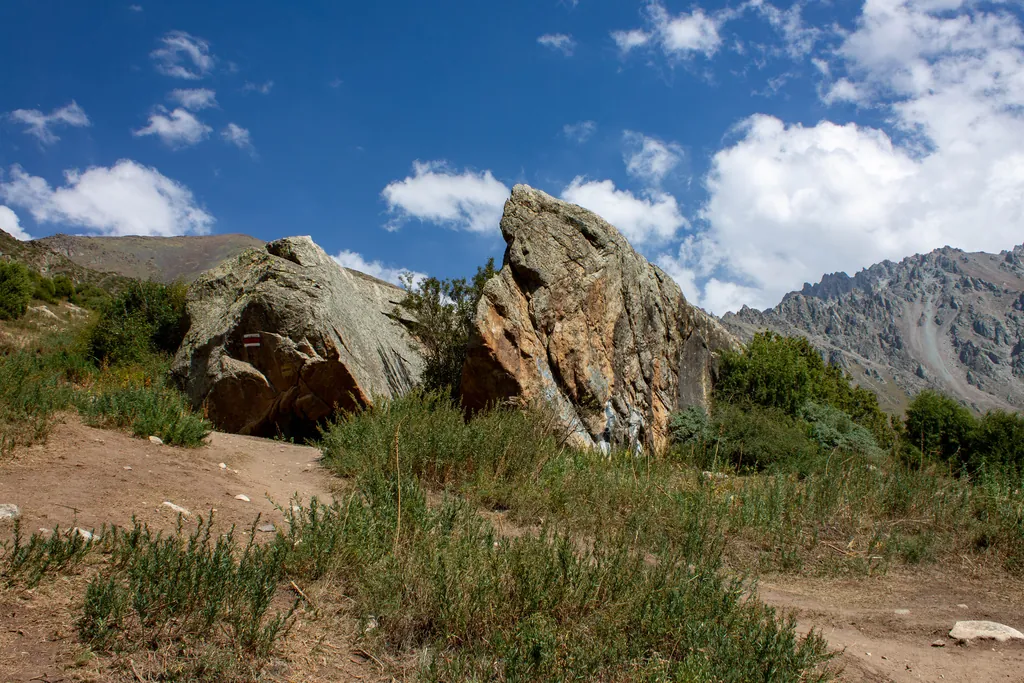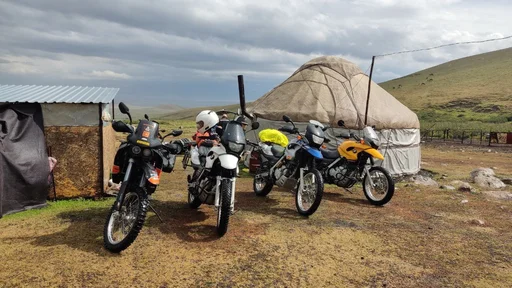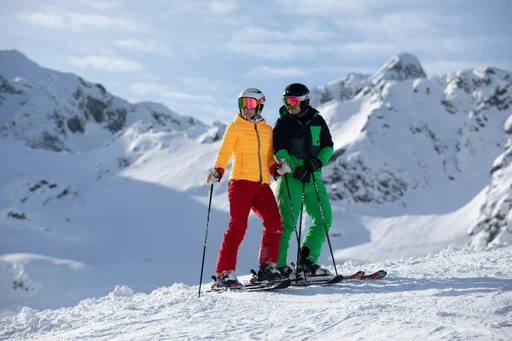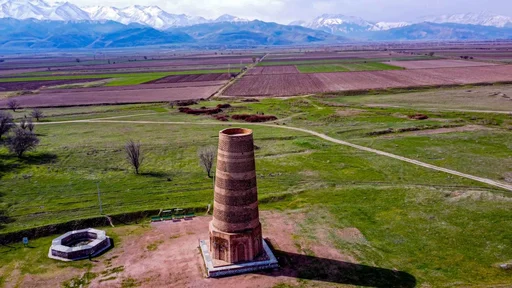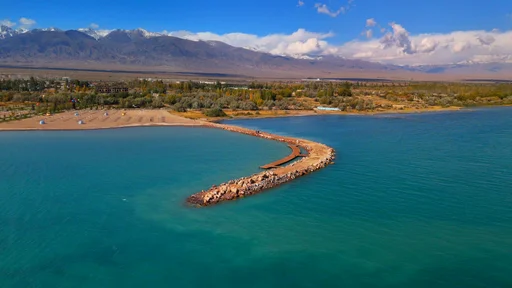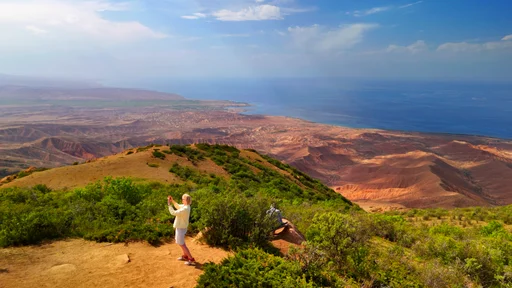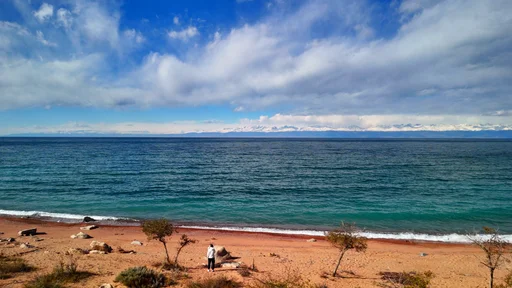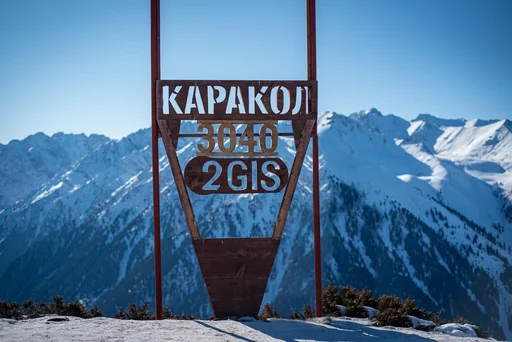Geography, Climate and Landscape of the Park
The Ala-Archa National Park is located on the northern slope of the Kyrgyz Ala-Too range, just ~40 km south of the capital, Bishkek. The park extends from the foothills (around 1500-1600 m above sea level) to glacier-capped peaks nearly 4900 m high (Semyonov-Tian-Shansky Peak, 4875 m). It covers approximately 200 km² of mountainous terrain, including the scenic gorge of the Ala-Archa River and its side valleys. The park’s landscapes are incredibly diverse: at lower elevations there are steppe foothills and coniferous forests, higher up - subalpine meadows, rocky cliffs, and perpetual snow. The park is beautiful year-round: summers in the gorge are moderately warm (daytime +25…+30 °C, cool nights), winters are snowy and cold, springs see fog and rain, and autumn is usually clear and warm. The optimal visiting season is late summer and early autumn, when the weather is most stable and mountain trails are accessible. Nevertheless, Ala-Archa is open year-round: in winter it attracts fans of snow trekking and ski mountaineering, in spring it delights those who appreciate vibrant alpine blooms, and in hot summer it offers the coolness of mountain rivers and forests.
History of the Park’s Establishment and Development
Ala-Archa Park was officially established on April 29, 1976 by decree of the Council of Ministers of the Kyrgyz SSR. The park’s founding aimed to protect the unique nature of the gorge and promote eco-tourism. However, exploration of these lands began long before 1976. As early as the 1950s, the Ala-Archa gorge became popular among climbers and tourists: the first mountain trails were laid here, and camps and base sites were organized. In 1951, the first mountaineering base was set up in the valley, and by the 1960s the area was known as a training ground for Soviet climbers. In 1967, even an asphalt road was built through the gorge, greatly improving access to the mountains. Thus, by the time the national park was founded, active-recreation infrastructure was already well developed.
After Ala-Archa was declared a national park, infrastructural improvements began: protected zones were defined, tourist routes and picnic areas were created, and a small Nature Museum was opened. During the Soviet era, mass ascents and climber gatherings took place here - a tradition that partly continues today. In the post-Soviet period, the park remained one of Kyrgyzstan’s calling cards. Thanks to its proximity to the capital and its unique nature, Ala-Archa became a must-visit destination for visitors to the country. In recent years, at the initiative of authorities, park infrastructure has received renewed development: hotels and campsites are being modernized, and plans are underway to launch Kyrgyzstan’s first mountain cable car to ease tourist ascents. At the same time, the park administration places emphasis on ecology - transport and other activities are being restricted to preserve nature. Today, Ala-Archa Park combines a rich history of exploration with a modern approach to eco-tourism.
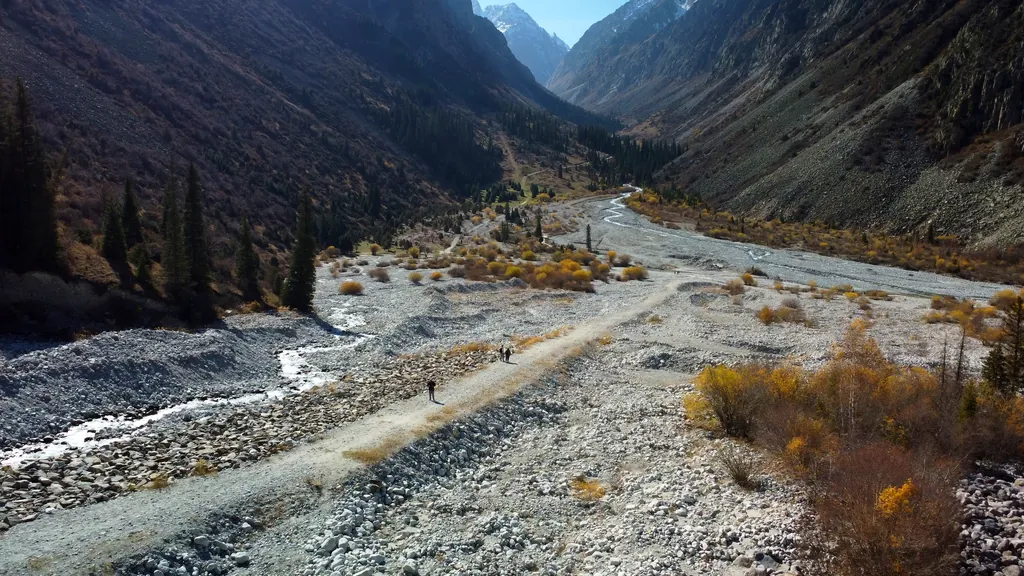
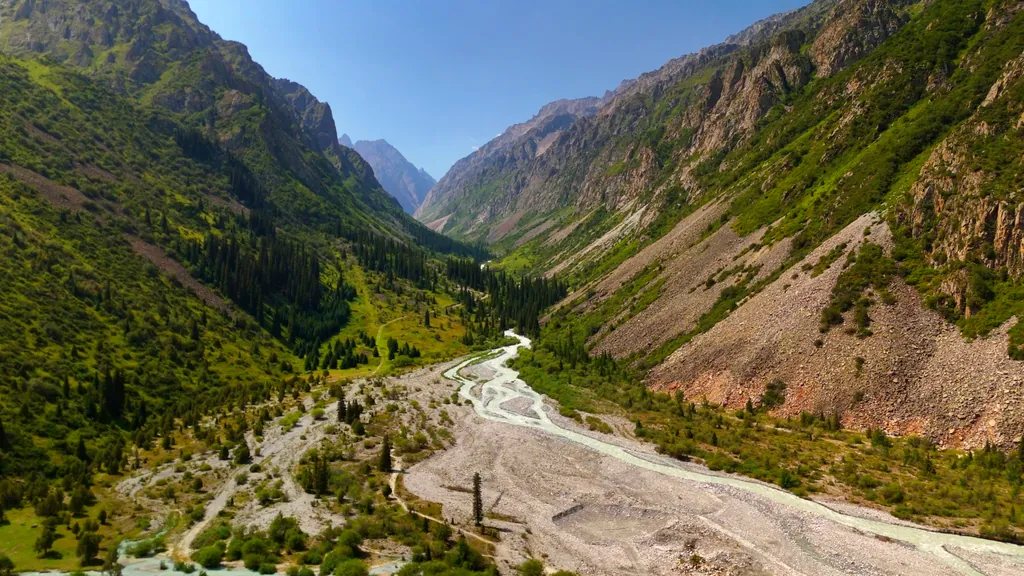
Natural Features: Rivers, Glaciers and Waterfalls
The park takes its name from the Ala-Archa River that flows through the entire gorge. In Kyrgyz, “ala-archa” means “variegated juniper,” referring to the abundance of juniper shrubs lining the valley slopes. The river originates high in the mountains, fed by melting glaciers, and rushes down the gorge, forming rapids and cascades. It has two major tributaries - the Ak-Sai and Adygine rivers - flowing from their respective gorges and glaciers. Within the park there are over 20 glaciers and about 50 mountain peaks. The largest glacier tongues lie in the upper reaches of the Ak-Sai valley - namely, the Ak-Sai Glacier, popular among climbers, and the Korona Glacier beneath its namesake peak. These glaciers not only feed the rivers but also create scenic waterfalls.
One of the most accessible natural wonders is the Ak-Sai Waterfall, about 35 m high, hidden in a narrow mountain ravine. From the viewing point at the “Broken Heart” rock, you can see the delicate silver streams of this waterfall in the distance. In spring, when the snow melts, the waterfall is especially voluminous and can be heard from afar.
A characteristic feature of Ala-Archa’s landscape is its high plateaus and meadows. One such plateau is Tepshie (2460 m), reachable even by novices: it is a spacious meadow on a mountain bench, accessible in a few hours’ hike from the base camp. From the plateau you get panoramic views of the entire Ala-Archa gorge and distant snow peaks - a true alpine scene. It’s an ideal spot for a rest and picnic, enjoying the clear mountain air and views of the sparkling river below. Higher up lie stark cirques of glaciers, but even from lower viewpoints you can glimpse the park’s legendary summits - for example, the jagged ridgeline of Korona Peak and the massif of Semyonov-Tian-Shansky Peak with its gleaming glaciers. Thus, within the compact area of Ala-Archa one finds a range of natural attractions - from roaring rivers and waterfalls to tranquil meadows and massive ice walls.
Flora and Fauna: The Realm of Juniper and Mountain Wildlife
Ala-Archa is renowned for its rich mountain ecosystem. About 600 species of higher plants have been recorded here, including over 70 species of trees and shrubs. In the lower part of the gorge grow Tian Shan firs (evoking a taiga feel) alongside groves of birch, poplar, and willow. The slopes are dominated by juniper thickets - both tall tree-like juniper and creeping shrubs. Juniper covers hundreds of hectares of the slopes. In spring, the mountain slopes bloom with flowers: red and white wild tulips, primroses, forget-me-nots, and other early ephemerals. More than 50 plant species in the park are considered medicinal and have been used by locals since ancient times - for example, infusions of certain alpine herbs help with colds, and rhubarb root is valued as a tonic. Juniper wood is also prized in Kyrgyz tradition - its smoke is used in purification rituals. By custom, dried juniper branches are burned to cleanse yurts or homes of evil spirits and disease. It is no coincidence that the park bears the name of this sacred plant.

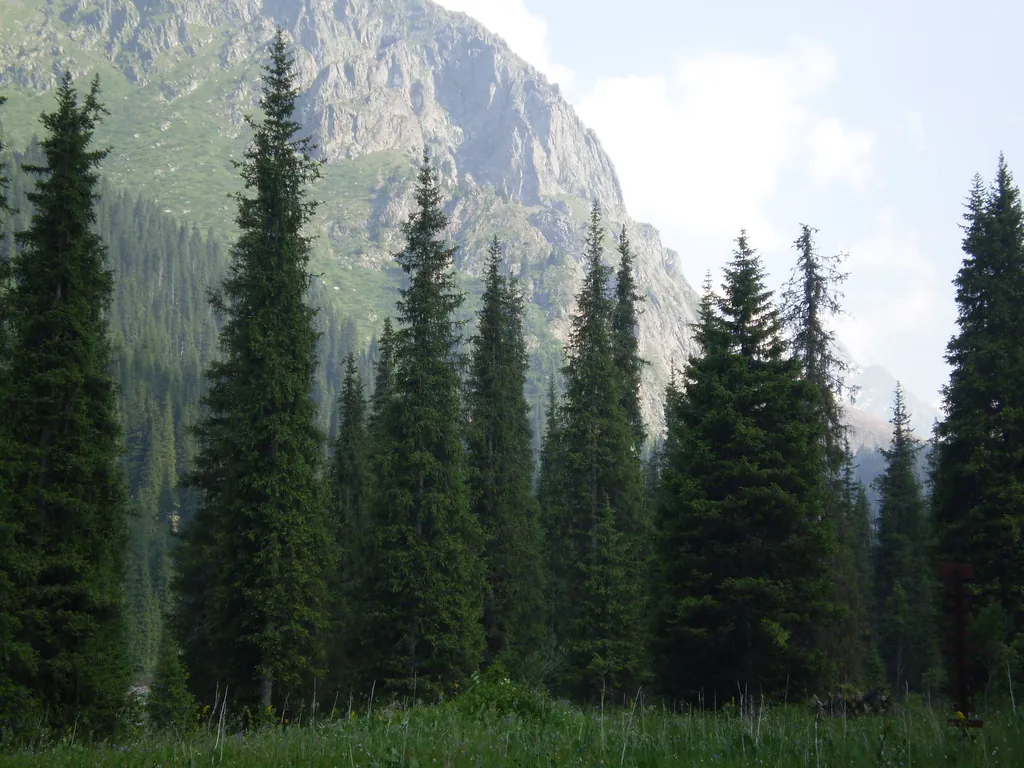
The park’s animal life is diverse given its relatively small area. In the fir-juniper forests at the base one may encounter foxes, wolves, stoats, hares, and even hedgehogs. On rocky slopes and high meadows live mountain ungulates: Siberian ibex, herds of argali wild sheep, and Asian roe deer. In summer, tourists often spot marmots, whose whistles warn their colony mates of approaching humans before they retreat to burrows. In the park’s remote corners roam rare predators - the Turkestan lynx and the legendary snow leopard (irbis). Spotting a snow leopard is a tremendous fortune: this elusive predator lives by night at altitudes above 2500-3000 m. Above the gorge’s skies soar raptors - golden eagles, Himalayan griffon vultures, and peregrine falcons. Early mornings bring the calls of rock ptarmigans and chukar partridges, and near rivers one glimpses colorful mountain finches. Thanks to its national park status, hunting is prohibited here, and wildlife is protected by park rangers. For scientists, Ala-Archa is a valuable field site: studies on restoring rare species populations, forest monitoring, and climate change impacts on alpine flora and fauna are conducted here.
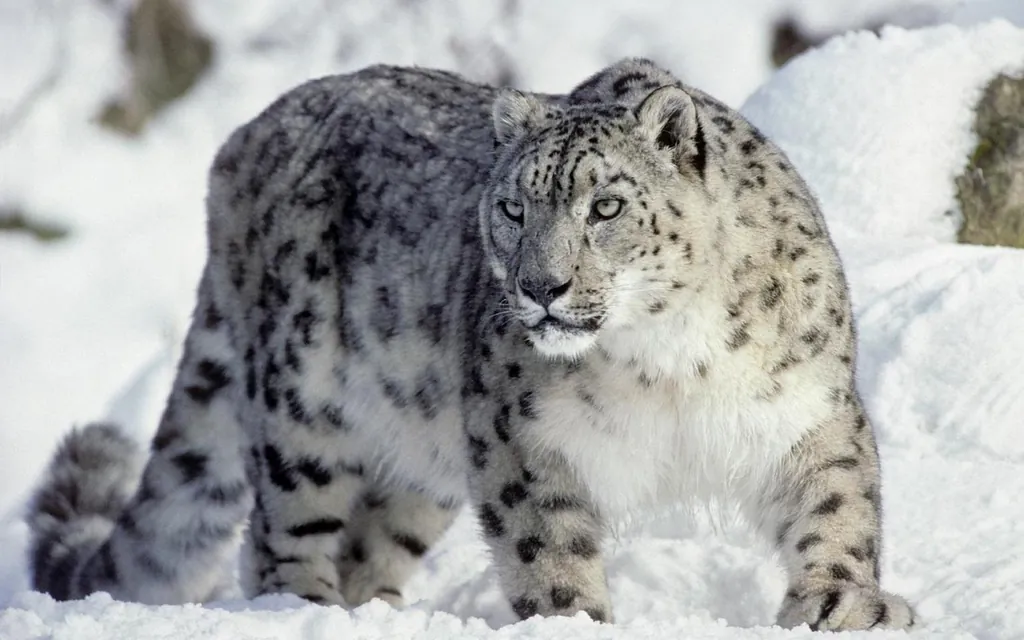
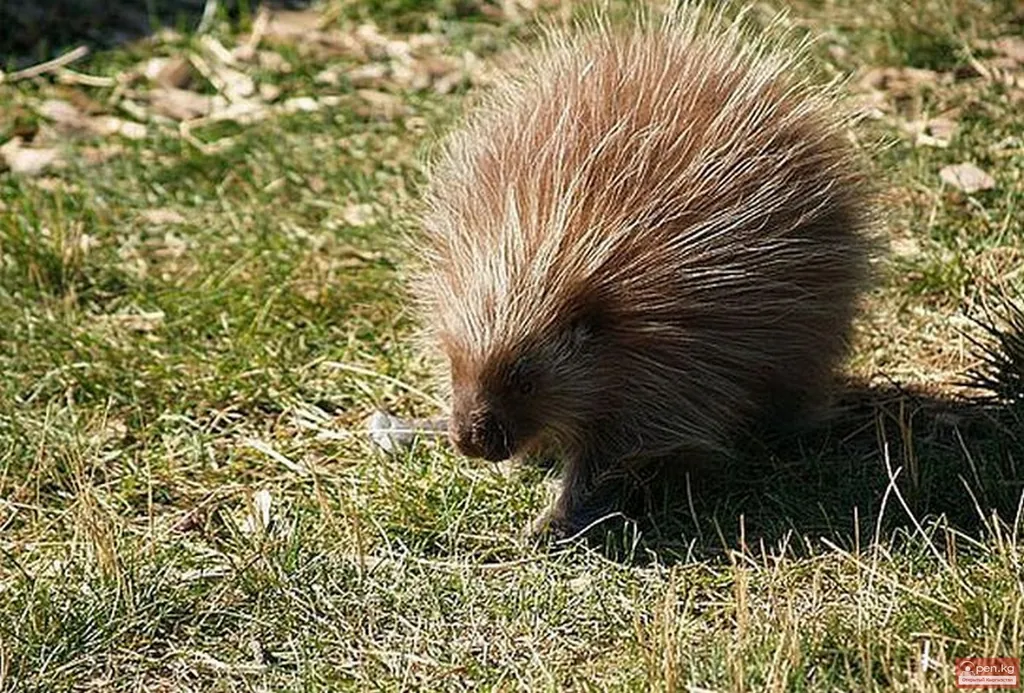
Mountaineering and Adventure Tourism: Conquering the Peaks
Ala-Archa is rightfully considered the mecca of mountaineers in Central Asia. As early as the 1950s the first climbing routes were explored here, and in the 1960s an all-Union mountaineering camp was established for training athletes. Over the decades the area has become legendary for ascents, with hundreds of routes completed. Today the gorge and its side valleys offer about 150 climbing routes of varying difficulty - from relatively easy 1B to extreme 5B and 6A. Moreover, the climbing season here is year-round: in winter ice climbing on frozen waterfalls and snowy gullies is popular; spring brings mixed ascents; and summer and autumn host the main flow of rock and high-altitude climbs.
The main base for climbers is the legendary “Ala-Archa” camp located on the Akty-Tor meadow at about 2100 m. From here most mountain routes begin. During Soviet times the alpine camp operated year-round, hosting climbers from across the USSR. The tradition continues: every May 1 the park holds a mass climbing festival, “Alpiniada,” when hundreds of enthusiasts pitch camps in the valley and make a symbolic group ascent of a nearby peak (traditionally Komsomolets Peak at about 4200 m). It is a colorful mountain celebration highlighting Ala-Archa’s status as the cradle of Kyrgyz mountaineering.
The park grants access to dozens of peaks over 4000 m. Directly from the Ak-Sai Glacier rise the famed Korona (4860 m) and Free Korea (4740 m) peaks - sharp rock spires beloved by technical climbers. Slightly east stands Semyonov-Tian-Shansky Peak (4875 m), the highest point of the Kyrgyz Ridge and the national park. Its massif is blanketed by extensive glaciers descending into the valley. Another popular summit is Uchitel Peak (4527 m), often climbed by trainees - it offers panoramic views of the park. Most climbers heading for Ala-Archa’s high peaks make camp at the “Ratzek Hut,” a small stone shelter perched at about 3400 m. Built in the 1960s and named after a renowned Soviet mountaineer, the hut now serves as a full base: tent platforms, a water source, and direct access to the key Ak-Sai valley summits. As such, it has become a “second home” for climbers worldwide - primuses constantly simmer, ropes dry, and tales of climbs abound. For professionals, Ala-Archa offers unique challenges: sheer 1000 m+ rock walls, complex ice routes on steep glaciers, and combined climbs across varied terrain. It is no wonder the park has hosted championships and training camps. Yet beginners are also welcome: the alpine camp employs experienced instructors who organize training ascents - even novices can learn the basics and summit a modest peak in 1-2 weeks. Thus, Ala-Archa is not just a protected natural area but a living monument to mountaineering history, continuing to inspire new generations of mountain enthusiasts.

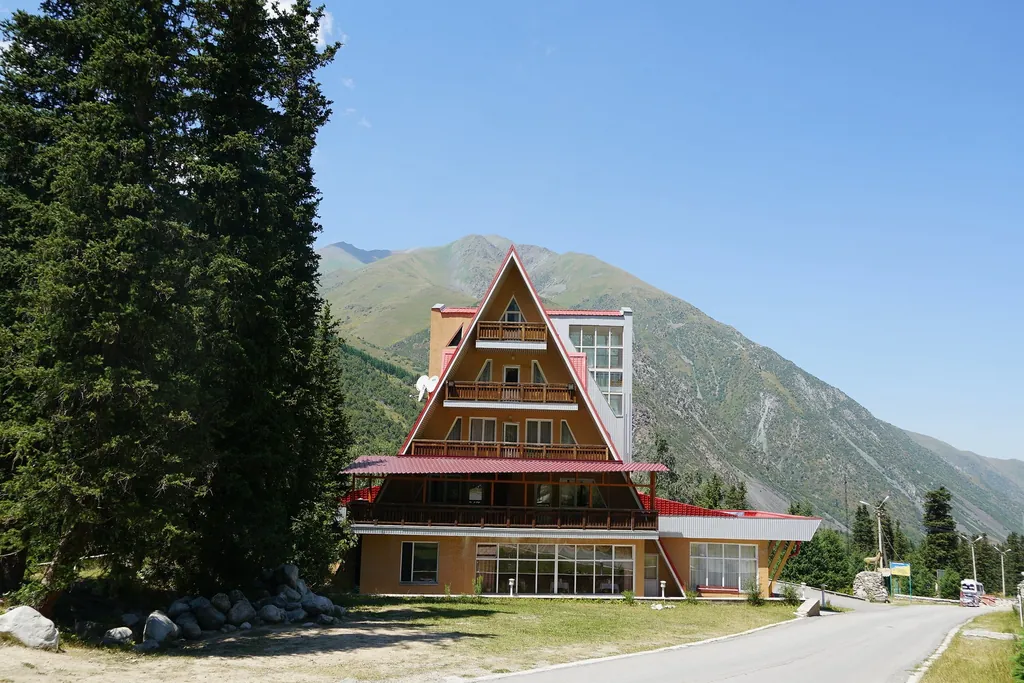
Main Tourist Routes and Treks
Hiking and trekking are the best ways to discover Ala-Archa’s beauty. The park features several routes of varying difficulty, from easy day trips to multi-day mountain treks.
Walk to Tepshie Plateau and the “Broken Heart” - an easy route (~3-4 hours round trip). The trail starts from the alpine camp (about 2200 m) and winds up through mixed forest. Within 30-40 minutes you reach the “Broken Heart” rock (2380 m) - a large boulder split like a heart. This popular viewpoint offers sweeping views of the Ala-Archa canyon and the distant Ak-Sai waterfall. After a photo stop, the trail continues for another half hour to the spacious Tepshie Plateau (2460 m). Here you can rest, have a snack, and enjoy the mountain tranquility. This route requires no special equipment and is suitable for families with children.
Hike to the Ak-Sai Waterfall - a moderate route taking 5-6 hours round trip. The route follows the same landmarks - the “Broken Heart” and Tepshie Plateau - then continues deeper into the Ak-Sai gorge. You will cross a mountain stream (via stepping stones or a log) and then climb more steeply through a pine forest. Eventually you enter the second valley, where the 35 m Ak-Sai Waterfall lies hidden behind cliffs. The cool mist and rugged backdrop make for an unforgettable picnic spot. Suitable for anyone in good physical condition, it demands care at crossings and ascents.
Extended Trek through Ala-Archa Valley - a 2-3 day route for the well-prepared. This journey follows the river’s main stem upstream, passing the alpine camp to deep tributary arms. The goal is the old high-altitude base (former ski shelter) about 10 km from camp. Along the way you’ll pass scenic spots: relic birch groves, the broad “Kashka-Suu” gravel terrace, and an abandoned weather station. Camp is pitched on one of the meadows. On day two you can summit a nearby peak (e.g., Orto-Sai ~4000 m) or visit a quiet lake in a glacier cirque. This trek immerses you in the park’s wild heart but requires solid fitness and gear.
All official routes are marked on a map at the park entrance, with trail markers along the way. Novices are advised to hire a guide - a cost-effective service in the park. A guide not only shows the way but shares local legends and points of interest. Remember safety: weather in Ala-Archa can change rapidly, so always bring warm layers and rain protection, even if it’s sunny at the base. Visitors are also urged to stay on trails to avoid getting lost or damaging fragile alpine flora. Overall, the park’s routes cater to all tastes - from a gentle waterfall walk to a full-fledged mountain adventure.
Cultural and Symbolic Significance of Ala-Archa
For Kyrgyzstan, Ala-Archa is more than a scenic spot - it is a national symbol. The image of towering mountains with dark green juniper-clad slopes has become one of the country’s icons, alongside Lake Issyk-Kul. The park is frequently visited by official guests and delegations, and its landscapes feature in promotional materials highlighting Kyrgyzstan’s tourism potential. To live in Bishkek and not visit Ala-Archa is considered a missed opportunity - many locals bring foreign friends here for their “first taste” of the Tien Shan.
Juniper (archa), which gives the park its name, holds a special place in Kyrgyz culture. Since ancient times, juniper branches have been burned as incense - smoke used to purify dwellings, livestock, and newborns by warding off evil spirits. This tradition (archa jyty) persists: you can buy dried juniper bundles at bazaars for purification rites. Many folk superstitions also revolve around juniper - for example, it is considered inadvisable to plant junipers too close to a home, lest they draw away human energy. Yet in the wild, juniper is sacred, believed to guard the mountains; cutting it was strictly forbidden. Thus, “Ala-Archa” resonates poetically for Kyrgyz people - as “a variegated, colorful juniper paradise.”
The park also inspires artists. Painters capture Ala-Archa’s vistas - from realistic landscapes to abstract works conveying the mountain spirit. Poets have dedicated verses to its grandeur. Folk tales speak of giants weeping (waterfalls) and juniper’s healing powers. Ala-Archa often features in tourism slogans as “an oasis of nature at the capital’s doorstep.” For Bishkek residents, the park is integral to life: weekend picnics, family celebrations (toi), and early education about mountain reverence all take place here. Hence, Ala-Archa is both a natural and cultural treasure of Kyrgyzstan - a place of strength and unity with the homeland.
Interesting Facts and Practical Tips for Visitors
Name and Legend: “Ala-Archa” means “variegated juniper.” According to one legend, sacred junipers of every shade once guarded the mountain entrance here. It is said that if you make a wish in the gorge and find a juniper cone, your wish will come true - thus the belief that juniper grants the dreams of those who enter the mountains with good hearts.
Park Records: The elevation difference in Ala-Archa is nearly 3.3 km (from ~1600 m at the entrance to 4875 m at the summit). The park contains over a dozen peaks above 4500 m - no other national park in Kyrgyzstan has so many high peaks within such a compact area. It also hosts the largest glacier on the northern slope of the Kyrgyz Ridge, the Ak-Sai Glacier, covering about 5 km².
Festivals and Events: Every May 1, the “Alpiniada” festival takes place - a mass climb with hundreds of participants. The festive atmosphere includes an evening campfire (now symbolic torch), guitar songs, sea of tents, and alpine club flags at the foot of the peaks. In summer, the park hosts trail runs, skyrunning competitions, and mountain bike marathons. Pre-pandemic, an eco-marathon began here in which participants ran 5 km while collecting litter along the route, competing for the cleanest trail.
Best Visit Time: The prime months are August and September, when rainfall is minimal and temperatures comfortable. The mountains are especially picturesque then: meadow greens turn golden, skies are clear, and fresh snow dusts the peaks. Spring (April-May) is also beautiful with blooming rhododendrons and tulips, though trails can be muddy from melting snow. In winter the road to the park is cleared irregularly but usually passable (preferably in a 4×4). Winter visitors should carry snow chains and check forecasts - avalanches can occur.
Respect Local Customs: Although close to the city, remember you are a guest in Kyrgyz nature. Greet shepherds and locals with “Salamatsyzby” (hello). Do not photograph people without permission, especially women in traditional dress who sometimes have photo shoots in the park. When visiting memorial sites (e.g., the mountaineers’ cemetery), behave respectfully.
Related News

